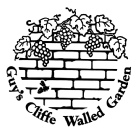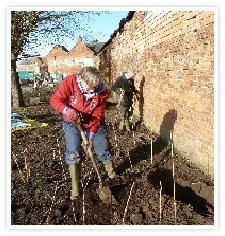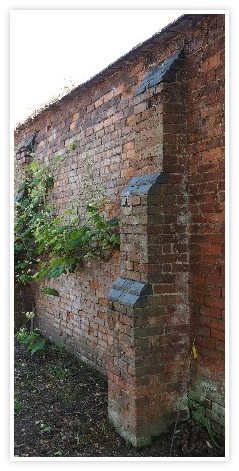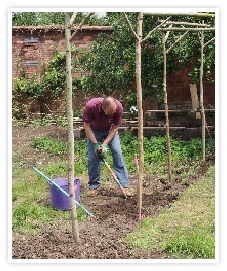
Guy’s Cliffe Walled Garden Trust : Email: trustees@guyscliffewalledgarden.org.uk


After Bertie’s death, the house and grounds were inherited by his granddaughter Ann Caroline and her husband, Lord Charles Percy. It was during their time that the garden probably had its best days. Certainly, Guy’s Cliffe garden was particularly successful at local and county horticultural shows winning many prizes for fruits, vegetables and flowers. The Ordnance Survey map of 1889 shows that the paths and beds defined by Bertie Greatheed, and the glasshouses built by him, were still in place and the garden was essentially as Bertie had left it in 1826.
The garden continued to provide for the owners of Guy’s Cliffe until the late 1940s when the estate was broken up and the main house eventually became a ruin. The kitchen garden was acquired by a market gardener, Mr Harwood, who worked the site until about 1960 when Hinton Brothers, a long-established Warwick nursery business, moved in. Hintons built some large glass houses on the two main beds at the north end of the walled garden but also used the old peach house and melon house for cultivation. The rest of the walled garden was used for growing annual and perennial plants for sale in the nursery. As recently as the early 1980s, the walled garden was still being used in this way but over the years it fell into disuse and quickly became overgrown. By 2014, when restoration work began, the garden was a jungle of tall brambles, established trees and ivy which had covered all the walls. Nothing was left of the pathways and the beds. A fire had caused considerable damage to the peach house so that only half of the original building was left and this, along with the melon house, quickly became derelict.
The garden is now entering a new phase with our restoration project and is both giving up its secrets and presenting us with new mysteries at every turn!

The walled garden was part of the kitchen garden that supported Guy’s Cliffe House. The kitchen garden extended to about 3 acres, with the walled section being about 2/3rds of an acre. The walled garden would have been used particularly for growing fruits and vegetables that needed the protection of the walls, which form a micro-climate for tender plants. Fruit trees were grown against the walls taking advantage of the warming effect of the sun on the bricks.
The earliest reference to the site of the walled garden that we have so far found is from a map dated 1773 when the land is described as being in use as a garden. At this time, the house was owned by Samuel Greatheed, MP for Coventry and a wealthy landowner. We do not know whether the walls were in place at that time but they had certainly been built by the early 1800s. A close look at their construction shows that it is unlikely they were built at the same time and were substantially altered at different times in their history.
Samuel left the estate to his son Bertie and during his ownership substantial development work took place in and around the garden. Between 1806 and 1826, Bertie spent a great deal of time and money on his estate and this included making many changes to the gardens. His diary of 1806 includes a line drawing of the walled garden which provides the first indication of the layout of the paths. It also lists which trees he had planted on espalier posts alongside them.
Bertie Greatheed also had the peach house and vinery built in the 1820s, copying a design used at Barford Hill House a few miles away, and had the garden walls altered so that he could grow more fruit trees against them. He boasted that he had half a mile of walls under cultivation. Another of Bertie’s projects was the ornamental canal that used to run along the outside of the west wall of the garden. The canal is now filled in but it could still be seen as recently as the 1960s.



The Walled Garden
 Back to topNext pageGuy's Cliffe HistoryThe GardenersThe Families
Back to topNext pageGuy's Cliffe HistoryThe GardenersThe Families| The Walled Garden |
| The Families at Guy's Cliffe |
| The Gardeners |
| 2015 Our Second Year |
| 2016 Progress |
| 2017 Progress |
| 2018 Progress |